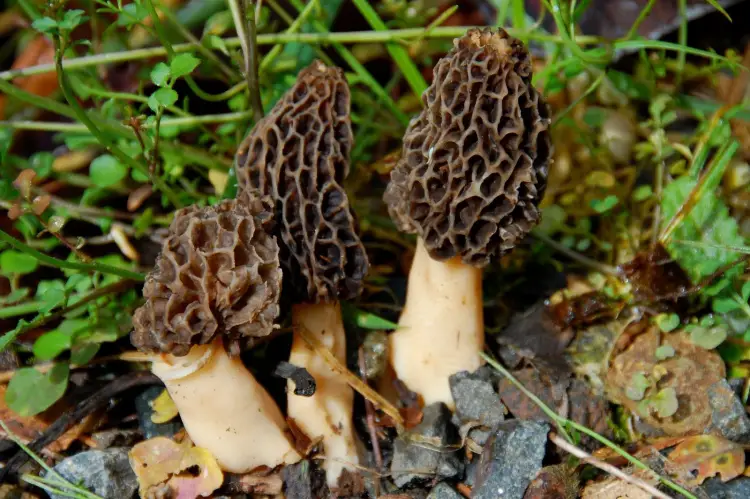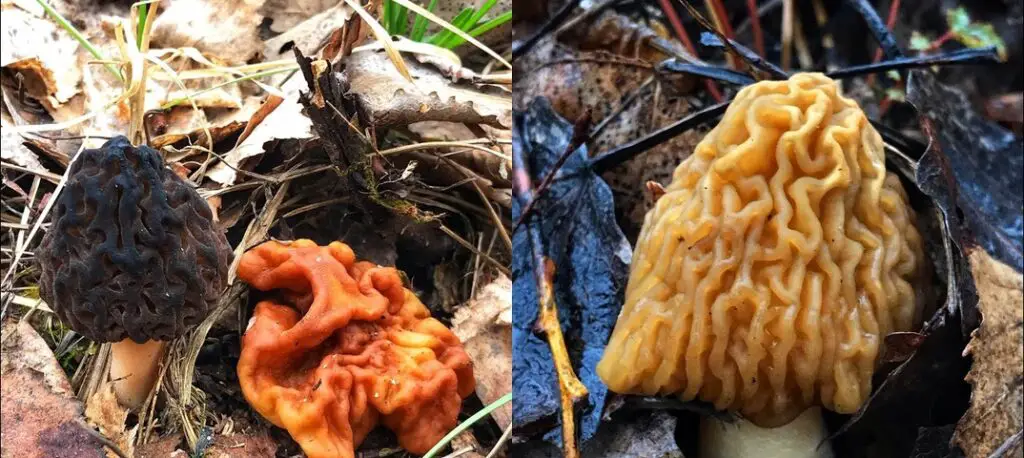It’s important to note that morel mushrooms grow in different regions and climates, so the best places to find them may vary depending on where you live. Additionally, the best time to find morel mushrooms is typically in the spring, but they can also be found in the early summer and fall depending on the location and weather conditions.
Table of Contents
10 Best places to find morel mushrooms

Hardwood forests
Hardwood forests, particularly those with ash, elm, and oak trees, are a great place to find morel mushrooms. This is because these types of trees are known to be associated with morel mushroom growth.
Ash, elm, and oak trees are deciduous, which means they lose their leaves in the fall. This allows for more sunlight to reach the forest floor, which can encourage the growth of mushrooms. Additionally, these types of trees are known to be host to a variety of insects and other organisms that can act as food sources for the mushrooms.
Morel mushrooms are known to grow at the base of these tree species, in the leaf litter, or near fallen trees. They are usually found in damp, shaded areas, and these trees provide a suitable environment for the mushroom. Want to know about How To Look For Morel Mushrooms?
Morel in Burned or disturbed areas
Burned or disturbed areas, such as recently logged or forest fire sites, can also be prime locations for morel mushrooms. This is because the conditions created by these disturbances can create a favorable environment for the mushrooms to grow.

For example, after a fire, the ash and debris left behind can act as a source of nutrients for the mushrooms, and the disturbance can also create open areas with more sunlight, which can encourage the growth of the mushrooms. Similarly, after a logging operation, the disturbance can create open areas with more sunlight, and the debris and wood chips can provide a suitable environment for the mushrooms to grow.
It’s important to note that it is generally not safe to forage mushrooms in the burned areas until the first heavy rain of the season, as the ash and debris can be toxic, and the heat can cause the spores to be dormant.
One specific example could be finding morels in the forest floor of a burned area in the Pacific Northwest, where forest fires are common and the climate is ideal for morels to grow, they can be found in the ash and debris left behind after a fire and along the newly exposed areas of soil.
Along riverbanks and streams
Along riverbanks and streams is another prime location to find morel mushrooms. The damp, shady areas near water provide the perfect conditions for these mushrooms to thrive. The moist soil, the water, and the microclimate created by the presence of water can make these areas ideal for the growth of morels.
For example, you might find morels growing along a stream in the Appalachian Mountains, where the cool temperatures, the damp soil, and the shaded areas near the water can create an ideal environment for the mushrooms to grow. The Appalachian Mountains are known for their rich biodiversity and the presence of morels is common in these areas.
In old orchards or apple tree groves
Old orchards or apple tree groves are another prime location to find morel mushrooms. The damp soil and shade provided by the trees make for ideal growing conditions for the mushrooms.
For example, you might find morels in an abandoned apple orchard in the Northeastern United States, where the apple trees provide the ideal microclimate, and the damp soil created by the irrigation systems and the humus created by the fallen apples and leaves make the perfect environment for the mushrooms to grow. These abandoned orchards can have a rich history and the mushrooms can be found in the same spot year after year.
In the vicinity of dead or dying elm trees
Morels often grow in the vicinity of dead or dying elm trees. The mushrooms thrive in the damp, rotting wood of the tree and can be found growing at the base of the tree or nearby. An example of this would be finding morels growing near a dying elm tree in the Midwest United States.
In damp, shaded areas under pine trees
Morels also grow well in damp, shaded areas under pine trees. The needles from the pine trees provide natural mulch which helps to retain moisture in the soil. An example of this would be finding morels growing under a pine tree grove in the Pacific Northwest.
In fields or meadows with a high concentration of wildflowers
Morels are also commonly found in fields or meadows with a high concentration of wildflowers. The wildflowers often grow in damp, shady areas, providing the ideal conditions for morels to thrive. An example of this would be finding morels growing in a meadow filled with wildflowers in the Northeastern United States.
In mossy, damp areas at the base of trees
Morels can also be found growing in mossy, damp areas at the base of trees. The mushrooms thrive in the damp, shaded conditions provided by the moss and nearby trees. An example of this would be finding morels growing at the base of a tree in a mossy forest in the Pacific Northwest.
Along hiking trails in the woods
Morels are also commonly found along hiking trails in the woods. These mushrooms can often be found growing in the damp, shaded areas near the trail. An example of this would be finding morels growing along a hiking trail in the Appalachian Mountains.
At the edge of a wooded area, where it meets a field or meadow
Morels can also be found at the edge of a wooded area, where it meets a field or meadow. The mushrooms thrive in the damp, shaded conditions provided by the nearby trees, but also receive enough sunlight to grow. An example of this would be finding morels growing at the edge of a forest in a meadow in the Midwest United
At the edge of a wooded area, where it meets a field or meadow, is a prime location to find morel mushrooms. This is because the transition zone between the woods and the open field creates a unique microclimate that can be favorable for mushroom growth.
For example, the woods provide a shaded and damp environment, while the open field allows for more sunlight and warmth. This creates a mosaic of conditions that can support a variety of plant and mushroom species, including morels. Additionally, this transition zone can also have an abundance of dead wood, leaf litter, and other organic matter that can act as food sources for the mushrooms.
For instance, A great example of this is at the base of a tree in a wooded area that meets a meadow, the soil is likely to be damp and rich in organic matter, which can provide the perfect environment for morel mushrooms to grow.
Conclusion
Morel mushrooms can be found in various environments such as hardwood forests, burned or disturbed areas, along riverbanks and streams, in old orchards and apple tree groves, and many other places. The best time to find morels is typically in the spring but it can vary depending on location and weather conditions. It’s important to abide by the laws and regulations for foraging for mushrooms and not to damage any natural habitats.